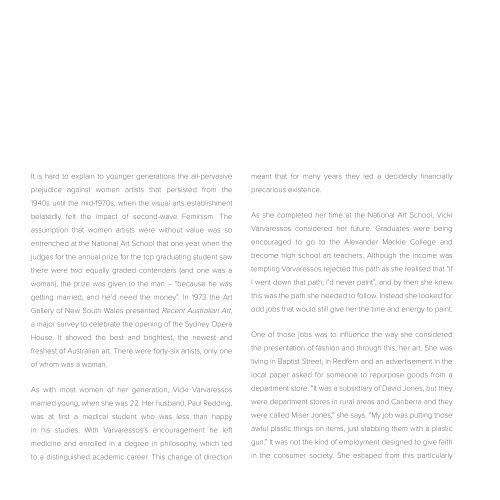SRGN_VickiV_Catalogue_42pp+4pp_PROOF_LowRes
Create successful ePaper yourself
Turn your PDF publications into a flip-book with our unique Google optimized e-Paper software.
It is hard to explain to younger generations the all-pervasive<br />
meant that for many years they led a decidedly financially<br />
deadening form of employment when the weaver Margaret<br />
Living so close to the centre of all that was passionate and<br />
prejudice against women artists that persisted from the<br />
precarious existence.<br />
Grafton, who she knew from the Darlinghurst Residents Action<br />
political, it was understandable that her first exhibition was<br />
1940s until the mid-1970s, when the visual arts establishment<br />
belatedly felt the impact of second-wave Feminism. The<br />
assumption that women artists were without value was so<br />
entrenched at the National Art School that one year when the<br />
judges for the annual prize for the top graduating student saw<br />
there were two equally graded contenders (and one was a<br />
woman), the prize was given to the man – “because he was<br />
getting married, and he’d need the money”. In 1973 the Art<br />
Gallery of New South Wales presented Recent Australian Art,<br />
a major survey to celebrate the opening of the Sydney Opera<br />
House. It showed the best and brightest, the newest and<br />
freshest of Australian art. There were forty-six artists, only one<br />
of whom was a woman.<br />
As with most women of her generation, Vicki Varvaressos<br />
married young, when she was 22. Her husband, Paul Redding,<br />
was at first a medical student who was less than happy<br />
in his studies. With Varvaressos’s encouragement he left<br />
medicine and enrolled in a degree in philosophy, which led<br />
to a distinguished academic career. This change of direction<br />
As she completed her time at the National Art School, Vicki<br />
Varvaressos considered her future. Graduates were being<br />
encouraged to go to the Alexander Mackie College and<br />
become high school art teachers. Although the income was<br />
tempting Varvaressos rejected this path as she realised that “if<br />
I went down that path, I’d never paint”, and by then she knew<br />
this was the path she needed to follow. Instead she looked for<br />
odd jobs that would still give her the time and energy to paint.<br />
One of those jobs was to influence the way she considered<br />
the presentation of fashion and through this, her art. She was<br />
living in Baptist Street, in Redfern and an advertisement in the<br />
local paper asked for someone to repurpose goods from a<br />
department store. “It was a subsidiary of David Jones, but they<br />
were department stores in rural areas and Canberra and they<br />
were called Miser Jones,” she says. “My job was putting those<br />
awful plastic things on items, just stabbing them with a plastic<br />
gun.” It was not the kind of employment designed to give faith<br />
in the consumer society. She escaped from this particularly<br />
Group, was awarded a grant to develop a major tapestry<br />
commission and asked Varvaressos to become her studio<br />
assistant.<br />
She was living in Victoria Street at Kings Cross when<br />
developers determined to demolish the old houses to build<br />
skyscrapers along the escarpment. The tactics they used<br />
were best described as brutal. Varvaressos became active in<br />
the Green Bans movement, determined to save inner Sydney<br />
from developers as money combined with political power and<br />
criminal intent. Many of the activists were making silk screen<br />
posters to spread their messages, but her medium has always<br />
been paint. She relished the tactile quality of the medium, the<br />
way that big sweeping brush strokes can evoke mood as well<br />
as image as she combined social critique and a painterly style.<br />
These early paintings combined acute commentary with a<br />
passionate expressive treatment in intense pigments. “It was<br />
the only way that I could still express things that were going on<br />
was to use images”, she recalls.<br />
at Watters Gallery, at Riley Street in Darlinghurst. At the time<br />
Watters was Australia’s leading avant garde art gallery. Its<br />
formidable reputation came from the way that Frank Watters<br />
and Geoffrey Legge remained open to new ideas and<br />
experiences, which included being prepared to look at the art<br />
of unknown young artists.<br />
Daniel Thomas, the most influential curator at the Art Gallery of<br />
New South Wales who also had a small column in the Sydney<br />
Morning Herald, did not usually write on an artist’s first solo<br />
exhibition but he noted that Varvaressos’s work showed<br />
“devastating individual observations of ethnic Sydney types,<br />
men in ugly moustaches.”<br />
The month of her exhibition coincided with an event that<br />
showed Varvaressos a darker side of Sydney as Juanita<br />
Nielsen, who had fought to save Victoria Street vanished,<br />
believed murdered on the orders of people unnamed. “It<br />
was horrible, horrible,” she says. “I can’t believe the idea that<br />
a woman could be murdered for objecting to development.


